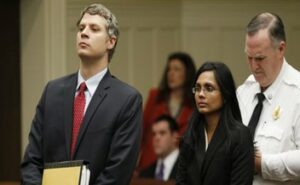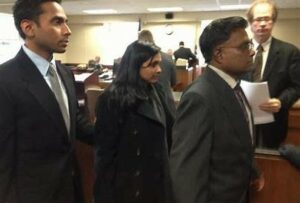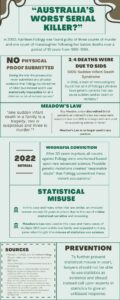A single person can hold the power to influence a decision in a court of law, oftentimes for the worse. In 2013, the governor of Massachusetts, Deval Patrick, assembled a task force to assess the identities of the people affected by the conduct of one of their most promising chemists who had been working at the Hinton Drug Laboratory in Jamaica Plain, MA since 2003. The task force was also assigned to enable the identified persons to respond appropriately to the misconduct granted to them by the court, based off of the work of this chemist. The name of the chemist in question was Annie Dookhan. After graduating from the University of Massachusetts, with a B.S. in chemistry, Dookhan applied for a job as a “Chemist I” at the Hinton Drug Laboratory. While she was initially limited to conducting preliminary tests, her work eventually earned her a promotion to “Chemist II” which allowed her to perform subsequent confirmatory tests.1 After compiling the data of all of the drug samples that Dookhan had tested between 2003 and 2012, over 37,500 suspects were found to have had their samples tested by her as a “primary” and “confirmatory” chemist. 2,000 of these identified individuals were incarcerated based on the testing that Dookhan did on the samples that were found in their possession. After further investigation, the task force discovered a maximum of 40,323 names whose cases were affected by the conduct of Dookhan at Hinton.2
So, why was this a big deal? What did Mrs. Dookhan do to warrant a thorough investigation into her work by the governor of the state at the time? Additionally, what kind of misconduct would the individuals who were convicted respond to that linked directly to her? In order to answer these questions, we first need to understand the nature of Dookhan’s work at the drug laboratory in Jamaica Plain, what her job demanded, and how the practice of “dry-labbing” ended her career.

One of Annie Dookhan’s primary responsibilities was the identification of questioned samples from a crime scene. The initial step in determining the nature of an unknown substance is to conduct a presumptive analysis. An example of a presumptive analysis is using sodium bicarbonate to react with the sodium nitroprusside that is present in methamphetamine to produce a blue color. 3 However, presumptive analyses only reduce the number of possibilities to a substance’s identity, since there exist multiple other compounds that can exhibit similar, if not identical chemical effects of a questioned sample. Thus, the second step of the identification process is a confirmatory analysis, which identifies the questioned sample by determining unique chemical properties. Confirmatory analyses are considerably more expensive and time consuming than their presumptive counterparts and require more sophistication and expertise, but they are more able to accurately identify any unknown chemical compound.
One example of a confirmatory analysis is the Fourier Transform Infrared Spectrophotometer (FTIR). This analysis confirms the identity of a questioned sample by measuring its unique interactions with infrared light. Often, an additional step is required, since most questioned samples arrive to the testing laboratory as mixtures, rather than pure substances. For identifying mixtures, the most common way that a forensic chemist does it is through Gas Chromatography-Mass Spectrometry. This instrument is first used to separate to separate the questioned mixture of compounds in the gas chromatograph. And then, using the mass spectrometer component, measure the mass of each separated element of the compound.4 Other responsibilities of a forensic chemist include conducting comparison analysis on questioned samples to determine their origin, as well as supplementing with classification and individualization to create a unique chemical fingerprint.
Dookhan specialized in illicit drug analysis. In addition to doing preliminary tests, she was also tasked with analyzing illicit substances. These include stimulants (cocaine, MDMA, and amphetamines), depressants (barbiturates, LSD, and certain opioids), and other miscellaneous narcotics (codeine and benzodiazepines).5 Annie’s problems, however, did not begin until June 2011, around the same time that control of the Hinton Drug Laboratory was transferred over to the Massachusetts State Police (MSP) forensics unit.
The first red flag of Dookhan’s misconduct was her record of testing approximately five times the monthly average of samples compared to her peers (500 per month versus 50-150 per month). If that was not suspicious enough, one of her co-workers testified to state police that despite her record, he had never seen Dookhan doing any sort of preliminary tests, at all. She was also known to weigh drug samples without doing a scale balance check first, a standard operating practice. It was also discovered that Dookhan had forged the signature of one of her colleague evidence officer’s initials into her logbook for false verification. Further probing by the state police revealed that Dookhan had intentionally tampered with test samples to get the results that she wanted. Such methods of tampering included making samples test positive for narcotics when it was originally negative and increasing the weight and number of samples to increase the sentences of the suspects who had them in their possession (by tampering with the test vials). She was also found to have removed 90 samples from the laboratory evidence vault without properly signing them out.6 These actions are what have come to be colloquially known as “Dry-Labbing”. The practice of falsifying experiment or test results in order to get a desired outcome.

But that was not the worst of it. During the investigation, it was also found that Dookhan had lied about her credentials. Some of her most outlandish claims on her resume were her graduating magna cum laude from high school, lying about her salary, boasting on having completed a Ph.D. dissertation in Harvard in just two years while working full time, and granting herself the titles of “on-call supervisor for chemical and biological terrorism” and FBI “special agent of operations.” 7 The truth is much more simplistic, and these were all false claims.
Despite these transgressions, Dookhan’s employers chose to ignore them until 2012. How could such a prestigious institution allow such incompetence to happen behind their doors? And how was Dookhan able to get away with her lies for 8 years? The Hinton Drug Laboratory at Jamaica Plain, MA was not a police laboratory for the majority of Dookhan’s career, but a private one. It was only transferred over to state police in an effort to cut costs. And while quality control parameters were put in place, they have failed to catch Dookhan in the act several times. And it’s not that the standards themselves were lax, they were not. The Hinton Laboratory adhered to industry standard protocols, such as the testing of all samples by two chemists and the use of sign-out logs for evidence.8 But for whatever reason, the Hinton Laboratory supervisors were lax and did not act at all for more than a year. This explains the various failures in management -lack of oversight, insufficient chemist training, and ineffective quality control- to do anything about Dookhan until she became a liability.9 It was only when the laboratory was placed under police management, did Annie get caught.
A strong code of ethics put into place at Hinton would have put a stop to Dookhan’s perjury before it even began. A code of ethics is strictly in writing. It isn’t enough to expect personnel to not lie about their work or the credentials that landed them said work, as not everyone shares the same moral convictions, and follows it to varying degrees. However, as most written forms of ethics are derived from mutual agreement and tend to overlap with generally accepted western moral values (such as the act of lying to the public being generally frowned upon), those who follow a code of ethics are held in high regard by the society that they service, and those that do not follow it will be held accountable and may not be able to keep their profession once exposed for their misconduct. A specific, clearly stated and thorough set of rules of what a scientific establishment expects their staff to follow if they want to keep their jobs and to ensure maximum efficiency in a laboratory environment with expert quality control on behalf of management to enable that efficiency to be sustainable in the long term.
A code of ethics must also be perceived by the public as a high standard for the practitioners of any profession to whom it applies. This will ensure accountability and credibility without sacrificing quality.10 If a similar framework was applied to the Hinton drug laboratory, it not only would have given the public of Jamaica Plain a perceived standard of high quality of the institutions that their tax dollars are funding, it would have also exposed Dookhan as both a liar and incompetent, while at the same time exposing the laboratory itself as plain incompetent. And it all would have been done within the first year of Dookhan’s career.

During Dookhan’s trial, she was discovered to have testified more than 150 times prior to being discovered for fraud. This was due to the 2009 Melendez-Diaz v. Massachusetts Supreme Court case which held that the 6th Amendment applied to laboratory analysts who tested evidence and required them to testify at trial.11 But what the verdict failed to do was given an adequate interpretation of the “Crucible of Cross-Examination”, which states that the reliability of evidence must be assessed in a certain manner. Unfortunately, the court at the time interpreted it as just the evidence being reliable, and as such, out of all of the 150 times that Dookhan had testified, not ONE defense attorney bothered to question her expertise or the evidence that she tested or even the credentials that she lied about. However, in December 2012, Dookhan was indicted on 27 counts of obstruction of justice, tampering with evidence, and perjury. Almost 1 full year later in November 2013, she entered a guilty plea on all 27 counts and was sentenced to 3-5 years in prison.12 She expressed remorse for her actions, and is quoted with saying “I messed up bad.”
The fallout of the Dookhan scandal proposed several reforms and laboratory safeguards for Hilton from attorneys. Among them were integrity testing, unannounced inspections, tighter evidence controls, evidence retesting, defendant access, the monitoring of analyst workstations, etc. The push for reforms also helped to restress the importance of forensic ethics.13 If only to ensure that it does not happen again.
- Driscoll, Sean K. “I messed up bad: lessons on the confrontation clause from the annie dookhan scandal.” Ariz. L. Rev. 56 (2014): 707, 715-716. ↵
- Meier, David E. “The identification of individuals potentially affected by the alleged conduct of chemist Annie Dookhan at the Hinton Drug Laboratory.” (2013), 2-3; Meier, David E. “The identification of individuals potentially affected by the alleged conduct of chemist Annie Dookhan at the Hinton Drug Laboratory.” (2013), 19-21. ↵
- David Collins, “Forensic Chemistry,” Brigham Young University 2 (2006, 7. ↵
- Collins, David. “Forensic Chemistry.” Brighan Young University 2 (2006), 8. ↵
- Smith, Fred. Handbook of forensic drug analysis. Elsevier, 2004, 2. ↵
- Driscoll, Sean K. “I messed up bad: lessons on the confrontation clause from the annie dookhan scandal.” Ariz. L. Rev. 56 (2014): 707, 716-717. ↵
- Driscoll, Sean K. “I messed up bad: lessons on the confrontation clause from the annie dookhan scandal.” Ariz. L. Rev. 56 (2014): 707, 717-718. ↵
- Driscoll, Sean K. “I messed up bad: lessons on the confrontation clause from the annie dookhan scandal.” Ariz. L. Rev. 56 (2014): 707, 717 ↵
- Bonventre, Catherine L. “Wrongful convictions and forensic science.” Wiley Interdisciplinary Reviews: Forensic Science 3, no. 4 (2021): e1406, 6 ↵
- Barnett, Peter D. Ethics in Forensic Science: Professional Standards for the Practice of Criminalistics. CRC Press, 2001, 14 ↵
- Driscoll, Sean K. “I messed up bad: lessons on the confrontation clause from the annie dookhan scandal.” Ariz. L. Rev. 56 (2014): 707, 709 ↵
- Driscoll, Sean K. “I messed up bad: lessons on the confrontation clause from the annie dookhan scandal.” Ariz. L. Rev. 56 (2014): 707, 718 ↵
- Driscoll, Sean K. “I messed up bad: lessons on the confrontation clause from the annie dookhan scandal.” Ariz. L. Rev. 56 (2014): 707, 724-727. ↵



2 comments
Madison Hinojosa
This pivotal case played a crucial role in setting the definitive standards for scientific experts and the meticulous testing protocols they must adhere to in modern legal proceedings. This insightful article not only sheds light on the profound impact of this case but also acts as a beacon for aspiring legal professionals, like myself, contemplating a future in the field of law. It serves as a testament to the dynamic nature of legal frameworks and the constant need for adaptation to ensure thorough and fair judicial processes.
Christian Lopez
For someone who wants to practice law in the future its always interesting to find out about cases that lead to large scale changes in the practice of law. This case established the modern requirements for scientific experts and their testing methods. I never heard of this case but I really enjoyed learning about how certain policies came to be.